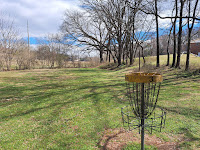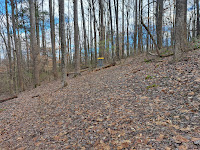Basic Information
Course Location: Athens Regional Park
Geographic Location: west of Athens, TN (35.45738, -84.63788)
Date Visited: March 2025
Number of Holes: 18
Course Length: 9050/7060 feet, par 67
Cost to Play: free
Difficulty Level: intermediate
Difficulty Level: intermediate
Carts: usable but expect some steep areas
Potential to Lose Discs: high due to forced water carry and deep woods
Park Information: https://athenstn.gov/team_athens/city_departments/parks___recreation/athens_regional.php
DG Course Review Page: https://www.dgcoursereview.com/courses/athens-regional-park-dgc.3378
Course Walkabout Video, Front 9: (coming March 13, 2026)
Course Walkabout Video, Back 9: (coming March 27, 2026)
Driving Directions: Between Knoxville and Chattanooga, take I-75 to SR 30 (exit 49). Exit and go east on SR 30. Drive SR 30 east 0.8 miles to Athens Regional Park's entrance on the right. Turn right to enter the park, then turn right at the first intersection (NOT on the paved walking trail). Park in the corner of the large parking lot on the left. #1 tee is to the northeast, across the park road and downhill.
Course Constructions:
Tees: concrete, 2 per hole
Baskets: mostly Discatcher, 2 per hole, red short basket and yellow long basket
Signage: hole signs on each tee, grey poles for back tees and blue poles for front tees; course map between #2 basket and #3 tee
Amenities: practice basket, walking trail, playground
Summary Review: 4.5 Stars (out of 5)
The disc golf course at Athens Regional Park is a sprawling layout that occupies a plot of land with lots of elevation. The course has 12 fairly open holes and 6 heavily wooded holes, but the heavily wooded holes occur consecutively. Thus, this course feels like it has less hole variety than the numbers suggest. This course has some tough and tight par 3's, but it also has some very open and easy par 4's. A paved walking path, a mountain bike trail, and a park road come into play on several holes, and there were a couple of times I had to wait for walkers or vehicle traffic before I could throw. I was the only player on the course when I came here on a pleasant Wednesday afternoon in early March. The course maintenance was fine on my visit. The course map only came in handy for navigation once: finding the tee on hole #7. Each hole has 2 tees and 2 baskets, which gives the course high replayability and high adaptability to the player's skill level. My biggest complaint about this course is that many of the open holes are just too open: they require a big arm but no strategy or shot execution. I prefer holes that require you to choose and execute a throw, and that is the only reason I do not give this course 5 stars. That said, I do see why a lot of people like this course, and I do recommend playing here at least once regardless of your personal preferences.
Hole-by-Hole Review
Distances taken from hole signs on the back tee. Picture sequence for each hole is 1) back tee, 2) approach to long basket, 3) long basket to tee.
Hole #1: 600/415 feet, par 4
Comments: slightly downhill, very open, fairly long, and very boring. 2 long throws will lead to a birdie opportunity. This hole is OK as a warm-up hole, but I'm glad every hole is not like this one. #2 tee is to the right beside the walking path.
Hole #2: 445/330 feet, par 4
Comments: same as the previous hole but gradually uphill instead of gradually downhill. Moving on.... #3 tee is to the left past the park office.
Hole #3: 470/355 feet, par 4
Comments: the first hole that merits some real thought and comments. This hole is a flat gradual dogleg left with a stream down the entire right side. A large tree on the left about 250 feet from the tee pinches the fairway tight and lowers the ceiling, but missing left is still better than throwing it in the stream: in or across the stream is out-of-bounds (OB). Aggressive players could even try to cut the dogleg by throwing left of the big tree, hoping to get a lucky bounce through the row of trees behind the big one. This hole is a great short par 4. #4 tee is to the right; cross the creek on the walking path bridge.
Hole #4: 525/440 feet, par 4
Comments: This hole plays the opposite direction as the previous hole on the other side of the stream. The hole is completely flat. Isolated trees guard either side of the fairway, but the fairway is rather wide. A couple of good throws should lead to a birdie opportunity, and this hole is only mildly more interesting than the first 2. Hopefully you're off to a good start, because this course is about to turn up the difficulty. #5 tee is across the park entrance road behind the basket.
Hole #5: 495/390 feet, par 4
Comments: this course's signature hole: a forced water carry over a pond. A slightly elevated tee helps your carry distance, but it's almost 300 feet to fully carry the water. Alternatively, you could lay-up to the left. The left side also gives you a better angle to attack the long basket, which is tucked behind a tongue of trees on the right. Whether you clear the water or not, you'll remember this hole. #6 tee is to the right.
Hole #6: 405/330 feet, par 3
Comments: the pond comes into play again on this hole, but now the pond is to the right. Trees pinch the fairway tight on the left, and low limbs overhang the left side of the fairway. In contrast to the easy par 4's at the start, this is a tough par 3. #7 tee is uphill to the left in the woods behind the parking lot.
Hole #7: 330/255 feet, par 3
Comments: Now the heavily wooded part of the course begins. A cluster of trees sits in front of the tee, and going around the cluster to the right provides the widest line and takes advantage of the right-to-left cross-slope in the fairway. There are plenty of other trees to negotiate, and this hole plays moderately uphill. This is another hard par 3. #8 tee is uphill to the right.
Hole #8: 430/305 feet, par 4
Comments: another tight moderately uphill hole. A right-to-left disc flight will get you the furthest up the fairway. Try to get to about 250 feet from the tee, the highest elevation on this hole, with your tee shot. From there, a relatively straightforward downhill throw remains to reach the long basket. This might be my favorite of the heavily-wooded holes. #9 tee is back toward the tee and downhill to the right.
Hole #9: 350/300 feet, par 3
Comments: back down the hill we go on a super tight hole. Multiple possible lines present themselves. The left line looks promising at first, but it leads to denser woods higher on the hill. The right line is tighter at first, but you will have more room to work with further down the hill. Some real thought is required on this hole. #10 tee is at the edge of the clearing behind the basket.
Hole #10: 340/290 feet, par 3
Comments: the tee is in the mowed-grass clearing, but 50 feet in front of the tee you head back into the woods. This hole plays straight up the hill. It is very tight, and you will need a slight left-to-right disc flight to stay in the fairway. The woods to the right are denser than the woods to the left, so try to miss left. This is another long, hard par 3. #11 tee is behind the basket.
Hole #11: 430/365 feet, par 4
Comments: a long double dogleg, first left and then right. This hole plays uphill, but the hill is not as steep as some other holes. Likewise, the fairway is tight but not as tight as some other holes. Birdie is very makeable here with a couple of well-shaped throws. #12 tee is to the right.
Hole #12: 570/425 feet, par 4
Comments: Now we break out of the woods for good, and the next 3 holes play southwest along the park's southeast boundary. The tee shot here is frustrating: you need a right-to-left disc flight to exploit the widest line out of the woods, but getting your disc heading left brings the park boundary into play. Thus, you have to be careful how far you bend and throw your disc. If you can get out of the trees, it is gradually uphill with no other obstacles between you and the basket. This is a par 4, so just make sure you get out of the woods with your tee shot, and then you can get aggressive. #13 tee is behind the basket; follow the edge of the woods.
Hole #13: 500/360 feet, par 3
Comments: a potential butt-kicker of a hole that forces you to use a straight but fairly tight line right along the park boundary. Keep your disc as straight as possible and hope you get a good ricochet off of a tree: a bad ricochet will lead to a recovery throw and a big number. This is another long, hard par 3. #14 tee is behind the basket; follow the edge of the woods.
Hole #14: 605/515 feet, par 4
Comments: a long gradual dogleg left with dense woods tight all along the left side. There is plenty of room to the right and no other obstacles between the tee and basket, so just don't miss left. #15 tee is to the right around the edge of the woods.
Hole #15: 590/515 feet, par 4
Comments: a long, mostly open hole that plays steeply downhill at first before flattening out. Try to keep your disc left of the row of trees at the bottom of the hill, but definitely avoid the dense woods to the far left. The basket is left of the row of trees, and the row is thick enough that getting through the row of trees is challenging but not impossible. Finding your disc in the dense woods to the far left might be impossible. #16 tee is across the park road to the right.
Hole #16: 735/520 feet, par 4
Comments: a very long and very open hole that plays across a small swale. Keeping your approach throw to the left avoids a single tree on the right. While there are a few trees to contend with, this hole is too grip-it-and-rip-it for small arms like me to enjoy. #17 tee is uphill to the right.
Hole #17: 660/470 feet, par 4
Comments: another mostly open hole. This hole is a slight dogleg right, and a cluster of red cedar trees guards the inside of the dogleg. The right-to-left cross slope in the fairway is this hole's main defense. Try to keep your disc as close to the top of the hill as possible for the shortest route around the dogleg. #18 tee is behind the basket and across the park road.
Hole #18: 570/480 feet, par 4
Comments: a downhill dogleg right with dense woods on the inside of the dogleg. The park road to the left is a safety hazard, but it is not heavily used. Missing left is definitely better than missing right. Despite the downhill, this is a worthy par 4: a narrow gap with a low ceiling just in front of the short basket prevents you from getting too aggressive with your approach. This hole is unorthodox, but I like it. The parking lot is across the park road to the left.






















































